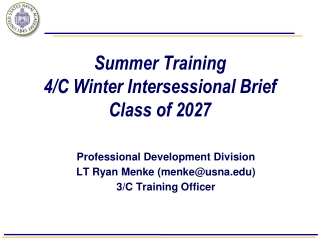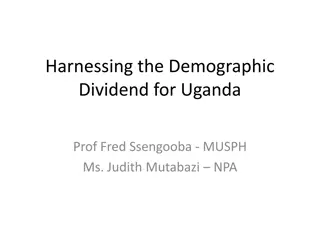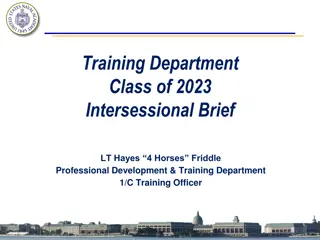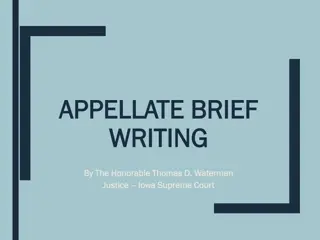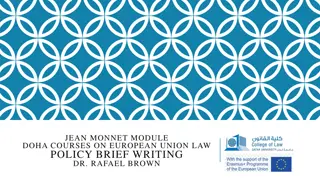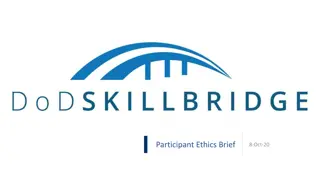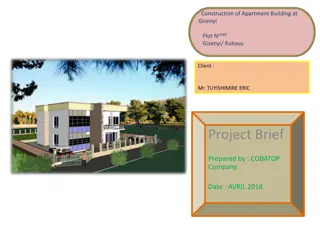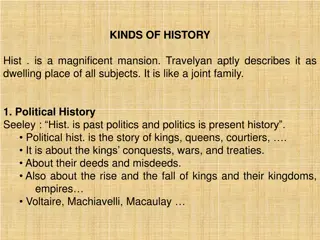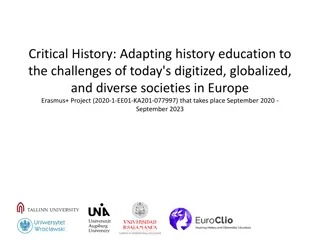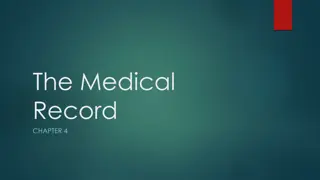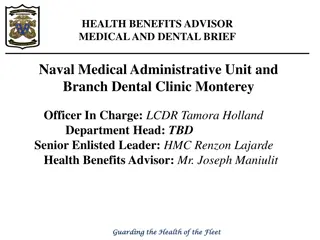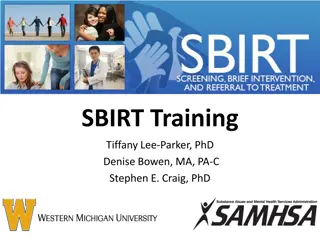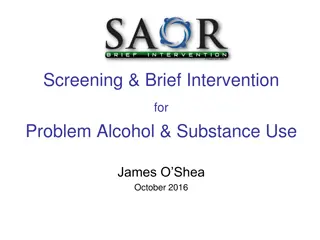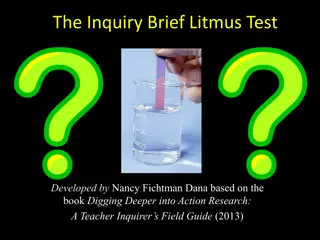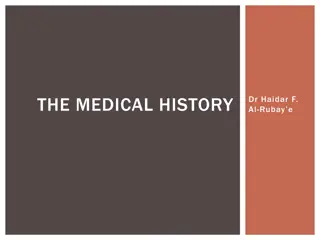
Evolution of Computers: From Vacuum Tubes to Transistors
Explore the fascinating history of computers from the era of vacuum tubes to the advent of transistors. Witness the progression of technology and programming methods through images and descriptions, showcasing the milestones in computer evolution.
Download Presentation

Please find below an Image/Link to download the presentation.
The content on the website is provided AS IS for your information and personal use only. It may not be sold, licensed, or shared on other websites without obtaining consent from the author. If you encounter any issues during the download, it is possible that the publisher has removed the file from their server.
You are allowed to download the files provided on this website for personal or commercial use, subject to the condition that they are used lawfully. All files are the property of their respective owners.
The content on the website is provided AS IS for your information and personal use only. It may not be sold, licensed, or shared on other websites without obtaining consent from the author.
E N D
Presentation Transcript
Some History Dr. Eng. Wassim Ahmad
First Digital Computer Created by Charles Babbage (1792-1871) Gears, etc. Never worked. Mechanical precision of that age was not good enough. First programmer: Ada Lovelace
Computers It s 1920. You are a mechanical engineer in the US. You tell your boss in the morning, I need a computer this afternoon. What would you expect to see in your office later that day?
The computer room (1940s NACA, precursor to NASA) Often parallel (pipelined or otherwise)
First Generation (1945-1955): Vacuum Tubes What s a vacuum tube No OS No assembly language Programmed by wires
Second Generation (1955-1965): Transistors and Batch Systems Discrete transistors Mainframes: large and very expensive Programming: Write on paper Punch on cards Take to operator Put into card reader Program runs Output comes out Operator takes your output and puts it in a bin
One OS of the time was called Fortran Monitor System (FMS). Typical FMS card deck: What if you dropped your deck? What if there is a bug? What if you need to add a statement?
Lots of time wasted while the operator walks around. Computer costs millions Batching:
Third Generation (1965-1980): ICs and Multiprogramming What s an IC? IBM 360 Idea of a family of computers, all same OS Multiprogramming: In the past, when doing I/O, CPU was idle. Okay when just lots of computation Lot more data processing jobs now, with lots of I/O
1976, Z80 Microprocessor 2.5 upto 6Mhz, 28 pins, 8 bits based.
Spooling (Simultaneous Peripheral Operation On Line): Card reader would put jobs on disk OS load new job from disk when done No longer really batching Though still often called a batch system Where do you see this today? Print spooling
Programming was very inefficient Timesharing (interactive computing) became more common. Use terminals, 80x24 was standard MULTICS, 1963 very advanced, precursor to (UNIX 1969) DEC PDP-1, 1961 4K of 18-bit words $940,000 First minicomputer .
The Fourth Generation (1980Present): Personal Computers With the development of LSI (Large Scale Integration) circuits chips containing thousands of transistors on a square centimeter of silicon. local computer manufacturer, Seattle Computer Products DOS (Disk Operating System). Gates then offered IBM a DOS/BASIC package. The revised system was renamed MS-DOS (Microsoft Disk Operating System) and quickly came to dominate the IBM PC market. successor to the IBM PC, the IBM PC/AT, came out in 1983, with the Intel 80286 CPU. MS-DOS was later widely used on the 80386 and 80486.
The Fifth Generation (1990 to present): Mobile Computers the first real smartphone did not appear until the mid-1990s when Nokia released the N9000. In 1997, Ericsson coined the term smartphone for its GS88 Penelope. most smartphones in the first decade after their inception were running Symbian OS. Now, Google s Android is the dominant operating system, with Apple s iOS a clear second the (first iPhone in 2007).
Pentium (Intel 80586) was introduced in 1993, followed by: Pentium Pro in 1995, Pentium II in 1997, Pentium III in 1999, Pentium IV 2001. Pentium M 2003. Intel Core i3, 2010. Intel Core i5, 2009. Intel Core i7 Ex, 2011. Intel Core i9, may 2017.
Summary (1950s) 1951 LEO I 'Lyons Electronic Office was the commercial development of EDSAC computing platform, supported by British firm J. Lyons and Co. 1953 DYSEAC an early machine capable of distributing computing 1954 MIT's Tape Director operating system made for UNIVAC 1103[3][4] 1955 General Motors Operating System made for IBM 701[5] 1956 GM-NAA I/O for IBM 704, based on General Motors Operating System 1957 Atlas Supervisor (Manchester University) (Atlas computer project start) BESYS (Bell Labs), for IBM 7090 and IBM 7094 1958 University of Michigan Executive System (UMES), for IBM 704, 709, and 7090 1959 SHARE Operating System (SOS), based on GM-NAA I/O
Summary (1960s) 1960 IBSYS (IBM for its 7090 and 7094) 1961 CTSS (MIT's Compatible Time-Sharing System for the IBM 7094) MCP (Burroughs Master Control Program) 1962 Atlas Supervisor (Manchester University) (Atlas computer commissioned) GCOS (GE's General Comprehensive Operating System, originally GECOS, General Electric Comprehensive Operating Supervisor) 1963 AN/FSQ-32, another early time-sharing system begun Titan Supervisor, early time-sharing system begun 1964 KDF9 Timesharing Director (English Electric) an early, fully hardware secured, fully pre-emptive process switching, multi-programming operating system for KDF9 (originally announced in 1960) Berkeley Timesharing System (for Scientific Data Systems' SDS 940) Dartmouth Time Sharing System (Dartmouth College's DTSS for GE computers) OS/360 (IBM's primary OS for its S/360 series) (announced)
Summary (1960s Continue) 1965 THE multiprogramming system (Technische Hogeschool Eindhoven) Multics (MIT, GE, Bell Labs for the GE-645) (announced) BOS/360 (IBM's Basic Operating System) TOS/360 (IBM's Tape Operating System) TSOS (later VMOS) (RCA) 1966 OS/360 (IBM's primary OS for its S/360 series) PCP and MFT (shipped) DOS/360 (IBM's Disk Operating System) 1967 CP-40, predecessor to CP-67 on modified IBM System/360 Model 40 1968 Airline Control Program (ACP) (IBM) THE multiprogramming system (Eindhoven University of Technology) TSS-8 (DEC for the PDP-8) 1969 TENEX (Bolt, Beranek and Newman for DEC systems, later TOPS-20) Unics (later Unix) (AT&T, initially on DEC computers) RC 4000 Multiprogramming System (RC) Multics (MIT, GE, Bell Labs for the GE-645 and later the Honeywell 6180)
Summary (1970s) 1970 DOS-11 (PDP-11) 1971 RSTS-11 2A-19 (First released version; PDP-11) OS/8 1972 Data General RDOS Operating System/Virtual Storage 1 (OS/VS1) Operating System/Virtual Storage 2 R1 (OS/VS2 SVS) Virtual Machine Facility/370 (VM/370), sometimes known as VM/CMS Virtual Machine/Basic Extended Product (BSEPP) Virtual Machine/Extended Product (SEPP) MUSIC/SP PRIMOS (written in FORTRAN IV, that didn't have pointers, while later versions, around version 18, written in a version of PL/1, called PL/P) 1973 -1 (Elbrus-1) Soviet computer created using high-level language u -76 (AL-76/ALGOL 68) VME implementation language S3 (ALGOL 68) RSX-11D RT-11 Alto OS
Summary (1970s) Continue 1974 DOS-11 V09-20C (Last stable release, June 1974) Multi-Programming Executive (MPE) Hewlett-Packard Hydra[ capability-based, multiprocessing OS kernel Operating System/Virtual Storage 2 R2 (MVS) 1975 CP/M Version 6 Unix 1976 Cambridge CAP computer[ all operating system procedures written in ALGOL 68C, with some closely associated protected procedures in BCPL Cray Operating System TOPS-20 Tandem Nonstop OS v1 1977 1BSD KERNAL OASIS operating system TRSDOS Virtual Memory System (VMS) V1.0 (Initial commercial release, October 25)
Summary (1970s) Continue 1978 2BSD Apple DOS HDOS TRIPOS UCSD p-System (First released version) Lisp machine (CADR) KVM/370 security retro-fit of IBM VM/370 KSOS secure OS design from Ford Aerospace MVS/System Extensions (MVS/SE) 1979 Atari DOS POS NLTSS UNIX/32V Version 7 Unix UCLA Secure UNIX an early secure UNIX OS based on security kernel MVS/System Extensions R2 (MVS/SE2)
Summary (1980s) 1980 86-DOS NewDos/80 OS-9 MVS/System Product (MVS/SP) V1 Virtual Machine/System Product (VM/SP) 1981 Acorn MOS Xinu first release Business Operating System PC DOS Pilot (Xerox Star operating system) MS-DOS iMAX OS for Intel's iAPX 432 capability machine 1982 Commodore DOS LDOS (By Logical Systems, Inc. for the Radio Shack TRS-80 Models I, II & III) QNX Sun UNIX (later SunOS) 0.7 Ultrix Stratus VOS[16]
Summary (1980s) Continue 1983 Lisa Office System 7/7 GNU (project start) Novell NetWare (S-Net) ProDOS SunOS 1.0 1984 Mac OS (System 1.0) MSX-DOS Sinclair QDOS QNX Virtual Machine/Extended Architecture Migration Assistance (VM/XA MA) 1985 Windows 1.0 MIPS RISC/os SunOS 2.0 Version 8 Unix Windows 1.01 Xenix 2.0 Virtual Machine/Extended Architecture System Facility (VM/XA SF)
Summary (1980s) Continue 1986 AIX 1.0 HP-UX SunOS 3.0 Version 9 Unix Cronus distributed OS 1987 Arthur IRIX (3.0 is first SGI version) MINIX 1.0 OS/2 (1.0) PC-MOS/386 Windows 2.0
Summary (1980s) Continue 1988 A/UX (Apple Computer) LynxOS CP/M rebranded as DR-DOS Mac OS (System 6) MVS/Enterprise Systems Architecture (MVS/ESA) SunOS 4.0 Virtual Machine/Extended Architecture System Product (VM/XA SP) 1989 RISC OS (First release was to be called Arthur 2, but was renamed to RISC OS 2, and was first sold as RISC OS 2.00 in April 1989) Version 10 Unix Xenix 2.3.4 (Last stable release)
Summary (1990s) 1990 OS/2 1.3 Windows 3.0 Virtual Machine/Enterprise Systems Architecture (VM/XA ESA) 1991 Linux 0.01-0.1 Mac OS (System 7) MINIX 1.5 RISC OS 3[25] Trusted Xenix[26] rewritten & security enhanced Xenix evaluated at TCSEC B2-class Amoeba microkernel-based, POSIX-compliant, distributed OS 1992 386BSD 0.1 AmigaOS 3.0 Amiga Unix 2.01 (Latest stable release) Solaris 2.0 (Successor to SunOS 4.x; based on SVR4 instead of BSD) OpenVMS V1.0 (First OpenVMS AXP (Alpha) specific version, November 1992) OS/2 2.0 (First i386 32-bit based version) Windows 3.1 1993 FreeBSD NetBSD Newton OS Windows NT 3.1 (First Windows NT kernel public release) IBM 4690 Operating System Novell NetWare 4 OS/2 2.1
Summary (1990s) Continue 1994 OS/2 3.0 Red Hat 1995 Digital UNIX (aka Tru64 UNIX) OpenBSD OS/390 Windows 95 1996 Mac OS 7.6 (First officially-named Mac OS) Windows NT 4.0 OS/2 4.0 Debian 1.1 1997 Mac OS 8 MINIX 2.0 1998 Solaris 7 (first 64-bit Solaris release names from this point drop "2.", otherwise would've been Solaris 2.7) Windows 98 Novell NetWare 5 1999 Mac OS 9 OS/2 4.5 Windows 98 (2nd edition)
For Summary of 2010 to 2017, file: OS history 2010-2017. For Full Summary of History of Operating System, file: OS history. Dr. Eng. Wassim Ahmad 2017

